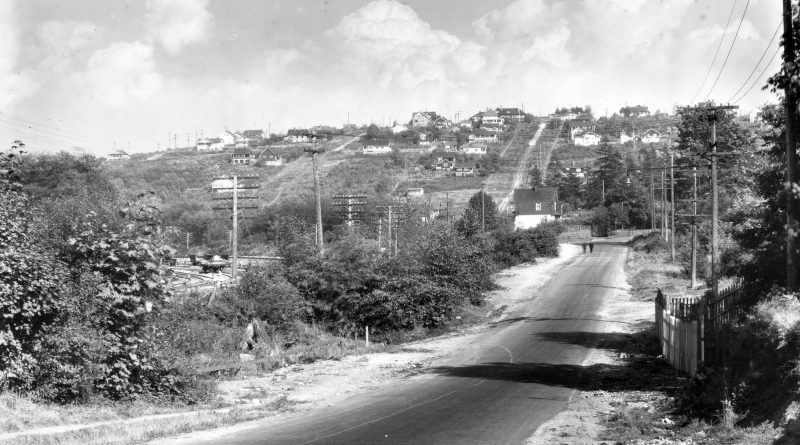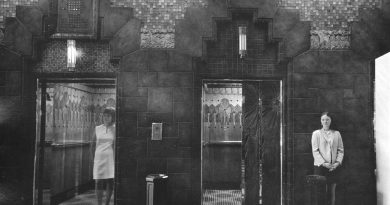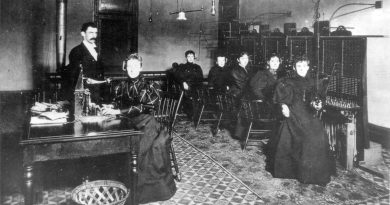1911
Above: View of Hastings Townsite
[Image: Vancouver City Archives AM54-S4-: Dist P169]
*****************************************
You’ll note that these years include events listed under “Also in . . .” These are events for which we don’t have a specific date. If YOU know the specific date of an event shown there, please notify us . . . and cite the source! Many thanks!
*****************************************
January 1 Hastings Townsite, the residents of which had voted to be annexed by Vancouver, became part of the city. (Today’s Glen Drive was the western edge of the townsite.) As well, a small chunk of CPR property called “No Man’s Land” was annexed by the city.
February 24 The first Vancouver Automobile, Motor Boat and Accessory Exhibition opened. Also February 24 Bill Miner, the “Grey Fox,” who had pulled off Canada’s first train robbery near Silverdale in the Fraser Valley in 1907, was captured in Georgia today and sent to the state pen. He would die there two years later.
February 27 North Vancouver Ferry No. 3 was launched from Wallace Shipyards, the first self-propelled boat of any size to be built in North Vancouver.
Also in February George Cunningham, aged 21, opened his first drug store at Denman and Nelson.
March 13 Actor and pianist John Emerson was born in Vancouver.
March Construction began on the World Building, what we know today as the Old Sun Tower.
April 11 Mandrake the Magician (Leon Mandrake), entertainer, was born in New Westminster.
April 28 William Templeton, who would later become the first manager of the Vancouver Airport, built and flew a home-made biplane at Minoru Park race-track today. This was the first plane built and flown in Greater Vancouver.
May 8 Fred Karno’s entertainment troupe from England began a week-long engagement at the Orpheum Theatre (not the present one) at Pender and Howe Streets. Among the performers, a 22-year-old not-yet-famous Charlie Chaplin. Our thanks to site visitor Robert Ingves for this item.
June 12 Real estate developers expected to get a boost in sales when the Burnaby Lake interurban line was activated by the B.C. Electric Railway.
June 24 The first nine holes of the Vancouver Golf Club in Coquitlam were opened for play. The club house was the old Austin farm house, with a dormitory for golfers who miss the last tram back to Vancouver or New Westminster.
June 29 Actress Katherine DeMille was born in Vancouver.
Also in June The Sea Foam was added to the West Vancouver Transportation Company’s ferry fleet with a capacity of 60 passengers. Sometimes it towed freight barges hauling West Vancouver residents’ furniture and effects.
July 1 The first full “peal” of the bells of Holy Rosary Cathedral. They are the only English-hung (that is, free-swinging) church bells in the city. There are eight bells, called into use for ceremonial occasions including weddings, funerals and ordinations. This first full peal commemorated the coronation of King George V. A full peal, in which the bells ring through more than 5,000 changes without a break, takes three hours.
July 11 Wallace Shipyards, the major employer in North Vancouver, was destroyed by fire. It was rebuilt almost immediately.
July 27 The Province reported that one third of Vancouver’s population had passed through the gates of Stanley Park during the week of July 10-16, making it “one of the most popular pleasure resorts the Terminal City possesses.” During the week mentioned “a census of every person entering the park was taken. A count was also taken of every auto, saddle horse, bicycle, dog, hack, and in fact every rig or conveyance . . . Sunday, the final day of the count, was of course the heaviest day of the week. On that day 21,738 pedestrians, 191 autos, 52 hacks, 367 rigs, 58 saddle horses, 148 bicycles and 173 dogs passed through the gates.”
Also in July North Vancouver Tennis Club held its opening tournament on its courts at 23rd and Lonsdale, the site of the present Recreation Centre.
September 15 North America’s biggest bank-vault robbery to date happened right in little old New Westminster. Five men—or was it three? accounts differ—bound and gagged a janitor at the city’s sole Bank of Montreal branch and got away with more than a quarter of a million dollars. Multiply that by about a hundred to gauge the impact today. The men “probably escaped down the Fraser River by a launch or else by automobile towards Vancouver, but of how they got away there is no direct evidence.”
The Province cartoonist had a field day with the heist. One of his drawings showed two cops interviewing an elderly neighbour. “Have you seen any suspicious persons?” they ask. “Yes,” she says, “there was two reporters here this morning.”
September 25 The name of Park Drive in East End Vancouver—so named because it ended at the time at Clark Park—is changed to Commercial Drive. The name was changed thanks to real estate promoters who wanted to bring into prominence what they predicted would be a great commercial thoroughfare.
October 10 The provincial courthouse opened on Georgia Street in a handsome building designed by Francis Rattenbury. Today the building houses the Vancouver Art Gallery.
October 18 The first elementary school in West Vancouver opened for classes in, says one source, the Presbyterian tent. There were 14 pupils.
October 30 Sports writer Jim Coleman was born in Winnipeg. He became the dean of Canadian sports reporters, moved to Vancouver. A newspaperman for 70 years, he died January 14, 2001.
December 12 A new Municipal Hall opened in Burnaby.
December 20 Lester and Frank Patrick opened the world’s largest artificial ice rink in Vancouver. Known as the Denman Arena, it burned down in 1936. For an excellent look at the Patricks, go to this website.
Also in December Charles Marega’s bust of David Oppenheimer, Vancouver’s second mayor, was installed in Stanley Park.
Also in 1911
BOMA, the Building Owners and Managers Association of British Columbia, was formed. Today, the association has more than 300 member firms and represents more than $7 billion in commercial real estate in the province, making it the largest commercial real estate industry association in British Columbia.
Vancouver’s population reached 120,847, double what it had been five years earlier.
The Journal of Commerce, Vancouver’s oldest magazine, began publishing.
Streetcar man Teddy Lyons became a “spieler” aboard BC Electric’s car #124. This was an open-air streetcar, and Teddy would describe the town to visitors. He pointed out interesting sights, told corny jokes and passed along local history. He did this for 39 years. Someone calculated he had travelled 930,000 kilometres through the city during his tour-guide career.
A company called Harbour Navigation began operating small ferry boats on the Fraser River. The company is still around under the name Harbour Cruises Ltd.
Dominion Construction was incorporated under the leadership of Charles Bentall.
Sun Yat-Sen made his third visit to Vancouver.
Construction began on St. George’s School at 3851 West 29th Avenue . . .
and on the Vancouver Rowing Club in Stanley Park . . .
and on the Point Atkinson Lighthouse . .
and the Stanley Park Dining Pavilion . . .
and the heritage building at 900 West Hastings that originally housed the Hudson’s Bay Insurance Co. . . .
and on Brock House at 3875 Point Grey . . .
and the First Baptist Church at 969 Burrard . . .
and B’Nai Yehudah (Sons of Israel), Vancouver’s first synagogue, at Pender and Heatley . . .
and the Canada Permanent building at 432 Richards . . .
and the Sylvia Hotel, 1154 Gilford . . .
and the Rogers Building at the northeast corner of Granville and Pender . . .
and North Vancouver’s new municipal hall . . .
and a tea house at the Capilano Suspension Bridge.
The Holden Building was built on Hastings Street, would serve as
Vancouver’s city hall from 1929 to 1936.
The CPR built Piers A and B.
London-born Helena Gutteridge arrived in Vancouver. She would go on to organize the B.C. Women’s Suffrage League, and fought for (and won) passage of B.C.’s first minimum wage act. (It varied by industry, but $13 to $15 a week was the range.) She would become Vancouver’s first woman alderman.
The first suffrage convention was held in Vancouver at O’Brien Hall, with Mayor Louis Taylor as chairman.
Twelve more stalls were added to the CPR roundhouse in Yaletown.
A 1,200-hectare tract called the University Endowment Lands was created out of the District Municipality of Point Grey’s western tip.
Early in 1911 South Vancouver ratepayers voted 1,914 to 200 in favor of annexation by Vancouver. The provincial government refused to permit it, said Vancouver was already over-burdened with administration problems.
The Canada Post Publishing Company Limited was established. Not long after, it became Broadway Printers.
Sculptor Charles Marega began teaching art for night school students.
A company called the Grouse Mountain Scenic Incline Railway was formed. It was created to build a 2.5-kilometre-long rail line that would carry its passengers up the mountain to a lavish resort hotel. But the scheme collapsed as the First World War loomed and steel became impossible to obtain.
Vancouver increased the number of wards to eight. With two per ward, there were now 16 aldermen.
A study found that 34 per cent of Vancouver’s population was British.
The Pacific Coast Hockey Association was founded. It would fold in 1924.
The Lonsdale Theatre opened in North Vancouver.
The first Vancouver Girl Guide Troop was started by Miss P. James.
Essondale Hospital’s Colony Farm was considered the best in the West, yielding 700 tons of crops and 20,000 gallons of milk. The farm provided therapy as well as food for its patients.
The Burnaby Lake interurban line started operation.
A Japanese school was established in Steveston by the Japanese Fishermen’s Benevolent Society. It had instruction in Japanese and a Japanese curriculum.
The Cloverdale telephone exchange opened with 209 subscribers.
Japanese settlers began growing strawberries in Surrey. The nearby community hall came to be called “Strawberry Hill.” The berries were sent to canneries in New Westminster and Vancouver.
A resolution was passed by Surrey Council to close the Serpentine and Nicomekl Rivers to navigation in order to construct dams for land reclamation. The era of steam boats and log booms on these rivers comes to an end.
A one-room school opened in White Rock. Another source says 1910.
A real estate boom in what will become West Vancouver sees waterfront lots advertised for as much as $4,500.
The western stretch of Dundas Street in Vancouver was renamed Powell Street, to honor Dr. Israel Wood Powell who, among other good works, donated the site of Vancouver’s first city hall.
Donald Mann, of the Canadian Northern Railway, was knighted. Port Mann was originally intended to be the road’s Pacific terminus. The Canadian Northern would become part of the Canadian National Railway in 1923.
It had been the old North Arm Trail, then it became River Road. In 1911 its name was changed again to Marine Drive, when Point Grey municipal council straightened and blacktopped it. The road was planned as a scenic loop around the Point Grey peninsula. It still is.
Henry Hudson School opened at Cornwall and Cypress.
The C.P.R., prompted by the imminent opening of the Panama Canal, announced plans to create a major shipyard at Westminster Junction (Port Coquitlam) complete with railway marshalling yards and an industrial complex.
Burnaby hired two mounted policemen and set aside $250 for the purchase of two horses.
The 2nd Cambie Street Bridge is completed. It will be in use for more than 70 years.
The Vancouver Fire Department is deemed by an international committee to be “one of the world’s finest . . . as regards equipment and efficiency” behind only London, England, and Leipzig, Germany. The city had 11 firehalls and 191 fire fighters.
Squamish chief Simon Baker was born on the Capilano Reserve.
Vancouver’s first Italian newspaper, L’Italia nel Canada, appeared.
Collingwood Heights School in South Vancouver was renamed for Sir Guy Carleton.
Walter Moberly School was built in Vancouver.
The Bank of Toronto and The Dominion Bank—which eventually merged—each opened second branches in Vancouver.
H.H. “Harry” Stevens became a Conservative MP for Vancouver. He would prove to be very influential.
The Vancouver Park Board, realizing the importance of playgrounds, established MacLean Park as the city’s first supervised playground.
First power produced from a concrete dam and 52.5 megawatt powerhouse located at the outlet of Stave Lake.
Nine-year-old Nat Bailey arrived in Vancouver with his family from Seattle. He would eventually launch the White Spot restaurant chain.
Wisconsin-born Julius Harold Bloedel began logging in BC.
Samuel Brighouse, one of the “Three Greenhorns,” left Vancouver for England, where he died in 1913.
Pauline Johnson published Legends of Vancouver.


![Nat Bailey Stadium [Image: Vancouver Heritage Foundation]](https://vancouverhistory.ca/wp-content/uploads/2021/01/0609fc04-48e0-41cd-810c-f53de847b9ad-A01624-1024x674-1-390x205.jpg)

